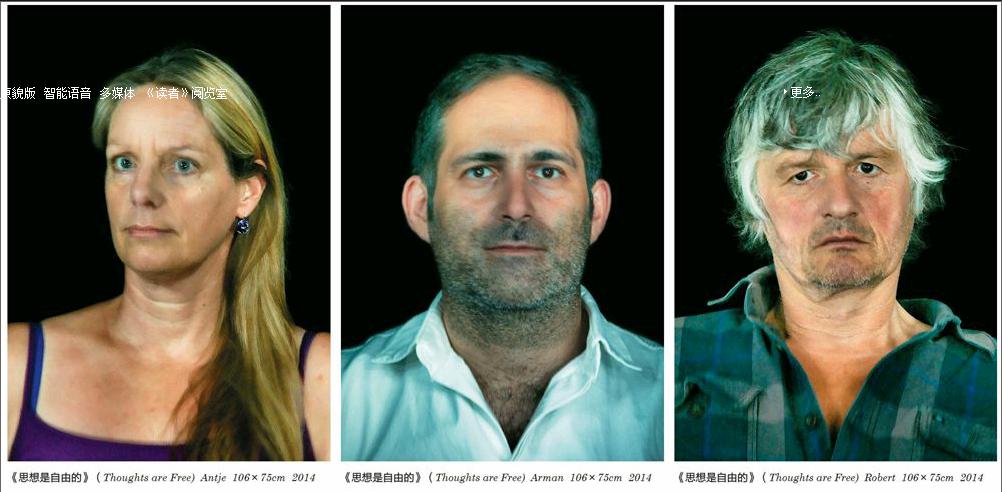迈克尔·诺伊布格 X东方艺术大家:信任与安全—自由与控制
2014-11-18费婷
费婷


平衡点
文/白江峰
交通是信息传送的链条,在纵横交错、快速高效的对接中,相对于一些显而易见的注意事项,某种心理层次的危险往往被视而不见。比如信任,
查尔斯·蒂利认为政治的基础就是“信任”,若失去这种信任,一切都将无从谈起。信任是进入交通系统迈出的第一步。
信任也辐射于其他事物之中,不存在没有信任基础的事物,个体与公共的关系就是信任与安全的关系。
在交通信任关系中,信任建立在陌生人身上,双方之间不存在制约性;也许存在某种制约性,那就是道德和良心。这种基础上的信任是盲目的。
秩序就是在信任基础上应运而生的。秩序可以增加个人在交通关系中个人信任指数和安全指数的提升,交通常识和驾照就是对个人交通行驶中的自由所做的基本控制。自由和控制,不存在没有限制的自由,亦不存在没有明文的控制,他们两者的制衡可以满足信任和安全的基本条件。但是,即便如此,信任和安全还是无法完全保证。在信任与安全的关系中,信任是公共的,安全是个人的;而把这种关系放在秩序中,自由是个人的,控制是公共的。
迈克尔·诺伊布格的作品《思想是自由的》和《凶兆警报》则把这种“信任与安全—自由与控制”的关系通过膨化而诡异的表情与交通关系中颜色属性的预支交叉了起来。绿色的正常通行与红色的禁止通行、蓝色的提示与橙色的警报。
而作品《世俗城市——仪式场所》则是对交通信任危机的内因做了基本辩证。城市化进程是人们需求改变的标志,从生理需求转变为安全需求,生理需求的矛盾会被安全需求的矛盾暂时雪藏起来。这些安全需求可以通过一些城市化的场所体现,他们是矛盾的,他们与生理需求冲突,但这些矛盾并不妨碍这些场所如机械化般运行,人们热衷于其中,如某种仪式一般,忘乎所以、不可自拔。
什么是城市?
城市是互动的物质及概念框架。它是高速度、高效率共生的法则。若无城市,人类及其文化将无法想象。
什么是交通?
交通不仅局限于物质运输,还意味着运动的控制(你不能以最高时速驶进你邻居的花园)。各种各样的信息都是交通。物体的位移以及我们接收、计算或散布的任何信息都是交通。如果我们以城市交通来形容城市的生命,那么交通规则限定了城市系统及其安全级别。城市系统的未来发展取决于当下的(交通)规则。
交通是城市系统的灵魂。
什么是马赫?
从步行到音速再到光速。
与汽车的行驶速度相比,马赫似乎非常快。这是如何运作的?物体虽无移动但它随信息的散发而摇摆(犹如摇摆中的空气分子运输着声音)。以音速扩散的信息是工作城市的秘密之一,并且它是数千年的限制器。当信息以光速超越城市的边界时,世界便处在了所有城市成为一体的全球状态。
What is City?
City is the physical and conceptual frame of interaction. It is the rule set for living together at high speed and high efficiency. Mankind and its culture is not imaginable without city.
What is Traffic?
Traffic goes far beyond physical transportation. Traffic means controlled movement (You cannot drive your car top speed through your neighbors garden). All kind of information is traffic. Displacement of physical objects as well as any information we receive, compute or distribute is traffic. If we describe a citys life by its traffic, the traffic rules define the system as well as the security level of the system. The future development of the system depends on the present (traffic) rules.
Traffic is the systems soul.
What is Mach?
From walking to sonic speed to the speed of light.
Compared to the speed of a car, Mach seems to be very fast. How does this work? Physical objects do not move but swing while distributing information (like swinging air molecules transport sound). Spreading information at sonic speed is one of the secrets of working cities and it was a limiter for thousands of years. As information now is available beyond the citys boundaries at light speed, the world is in a status of global merging of all cities. The speed of information / traffic changes the applicability of the traffic rules.
About my work:
Sometimes people call me an architectural photographer. This is ridiculous. I never picture buildings. My interest is focused on places – places of social interaction. The city is the universal place as human culture cant be imagined without. More than 50% of humans worldwide living in cities nowadays and dynamics accelerated - in the mechanical age and now in the communicational / informational age.
In my work, I never approach humans directly, as this would limit the possibilities of the beholder substantially. Thats why I show cities crowded places often without people or only in a distant way. My new portrait technique (Monoliths / Thoughts are free) provides the ability to explore peoples faces but keeping their unity instead of freezing / “killing” them.
Trust and Security – Freedom an Control
Thoughts are free is a statement and a postulation. It is also the title of an old German song addressing the topic.
Threat Alert shows calm places in big cities. While looking peaceful, people feel a little bit uncomfortable as cities could be and have been attacked easily. As security is the primary demand in Maslows hierarchy of needs beyond physical needs it is fundamental to people.
Put it together and you will find that the balance of freedom and control is crucial. Thats a constant in all human societies over all ages.
Secular Cities – Ritual Places
It is all about fetishes. All the pictured places show “temples” of human fetishes like life, death, sex, advertising, 24/7, communication, mobility, commuting, etc. It is a technique of the appropriate exposure to discover the fetishes in these places.
Citism
How does the concept of “city” form in our minds as a picture? I started to analyze the ways how the global memory of pictures is developed.
When I was young and I traveled to unknown places I developed an idea of how it would look like – and I was always proven wrong. Nowadays I am no longer surprised visiting unknown places, as the places images are always faster in my mind as I physically travel. 矛盾是不同需求间的纽带,在城市化、高效率、机械化的运转中,纽带常常纠结于城市角落的一隅;当然,最初的单项需求转为双向需求,使得人们的内心产生了极大的反差,矛盾也在这种转变中升级。而这种变化我们始料未及,我们无法追溯他的过去,因为他的过去在另一个矛盾的夹层里。这种癫狂的仪式不再是单纯的迷恋,而是一种“主义”。
由交通信任和安全缔结出的交通秩序中,解决制约与平衡的问题就是解决信任与安全、自由与控制和矛盾与变化的问题。很多时候,人们天真地相信,制约的力度越大,平衡也就会越接近;结果是制约变大,矛盾也变大,平衡无从谈起。如何找到一个平衡点,适度地调整制约与矛盾的关系,不使得两者的差距扩大,是当务之急。
关于我的作品:
有时,人们称我为建筑摄影师。这很荒谬。我从未拍摄建筑物。我的兴趣主要集中在场所—社会互动场所。城市是普遍场所,因为人类文化没有它将难以想像。当今,50%以上的人口居住在世界各地的城市,并且还在持续增长—人们生活在机械时代,如今更是通讯/信息时代。
我的作品从未直接指向人类,因为这会限制观者的基本可能性。这就是我为何要展示城市中拥挤无人或只是远远拍摄场所的原因。我的新的肖像技术(磐石/思想是自由的[Monoliths / Thoughts are free])可以探究人们的脸,但保留了他们的完整性而非冻结/“杀死”他们。
信任与安全—自由与控制
《思想是自由的》是一种陈述和假定。同时,它又是德国一首老歌的歌名,歌唱着(自由的)主题。
《凶兆警报》(Threat Alert)展示的是大城市中宁静的场所。这些场所看起来很平静,但是人们能觉察到一丝不安,因为城市易受到外来的袭击。当马斯洛需求层次理论中的安全需求成为主要需求时,它便超越了人们的基础需求,即生理需求。
将这一切联想起来,你会发现自由和控制之间的平衡是多么的至关重要。那是所有时代中人类社会的永恒。
世俗城市—仪式场所
这个系列都与拜物有关。所有被拍摄的场所都体现了人类拜物的“神庙”,譬如生命、死亡、性、广告、24/7(译注:一天24小时,一星期7天的缩写,即全天候提供服务年终无休的意思)、通讯、流动性、通勤等。恰当的曝光技术能够发现这些场所的拜物。
城市主义
我们的脑海里是如何形成“城市”概念的?我开始分析照片中全球性记忆的形成方式。
当我年轻之时,我去了许多未知场所,我开始想它将来会是什么样子—而我总是猜错。如今,我不再为来到未知场所而感到惊讶,因为这些场所的形象总比我脑海中曾留下过的印象变化得快。
About my work:
Sometimes people call me an architectural photographer. This is ridiculous. I never picture buildings. My interest is focused on places – places of social interaction. The city is the universal place as human culture cant be imagined without. More than 50% of humans worldwide living in cities nowadays and dynamics accelerated - in the mechanical age and now in the communicational / informational age.
In my work, I never approach humans directly, as this would limit the possibilities of the beholder substantially. Thats why I show cities crowded places often without people or only in a distant way. My new portrait technique (Monoliths / Thoughts are free) provides the ability to explore peoples faces but keeping their unity instead of freezing / “killing” them.
Trust and Security – Freedom an Control
Thoughts are free is a statement and a postulation. It is also the title of an old German song addressing the topic.
Threat Alert shows calm places in big cities. While looking peaceful, people feel a little bit uncomfortable as cities could be and have been attacked easily. As security is the primary demand in Maslows hierarchy of needs beyond physical needs it is fundamental to people.
Put it together and you will find that the balance of freedom and control is crucial. Thats a constant in all human societies over all ages.
Secular Cities – Ritual Places
It is all about fetishes. All the pictured places show “temples” of human fetishes like life, death, sex, advertising, 24/7, communication, mobility, commuting, etc. It is a technique of the appropriate exposure to discover the fetishes in these places.
Citism
How does the concept of “city” form in our minds as a picture? I started to analyze the ways how the global memory of pictures is developed.
When I was young and I traveled to unknown places I developed an idea of how it would look like – and I was always proven wrong. Nowadays I am no longer surprised visiting unknown places, as the places images are always faster in my mind as I physically travel.
